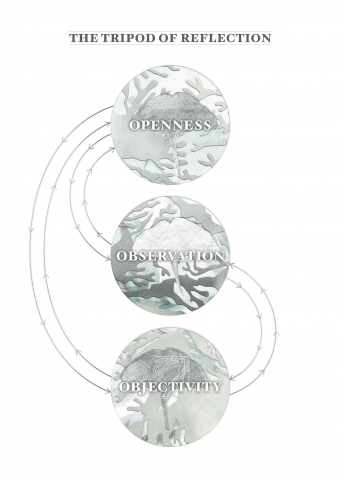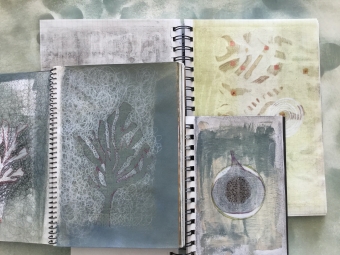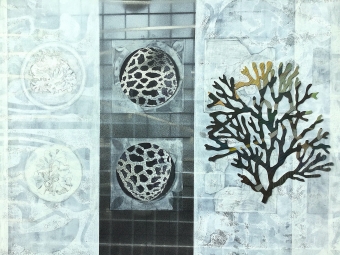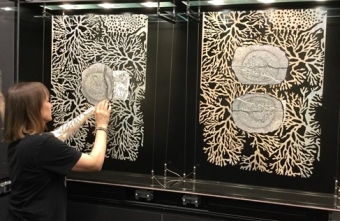Title: A sense of coherence: Drawing for the mind
Introduction
In 2020 I have been involved in research and work related to a number of ongoing community based projects, including an externally supported mentoring project for the Clitheroe Foundation: https://artdesign.unsw.edu.au/whats-on/news/emerging-artist-award-takes-art-design-students-sculpture-sea
I have also continued to work on a community-based education initiative related to people who have anxiety and depression (see below). As part of this work I have ongoing collaborations with external groups including the Fisher Library at The University of Sydney, the Royal Botanic Garden Sydney, and the Royal Botanic Garden Edinburgh.
Drawing can represent aspects of thinking in a visual form, but it can also be an effective experiential tool when it is proactively used to create a sense of calm engagement with the natural world around us. Drawing can help us to slow down, observe, and see more clearly, to bring a focus of quiet, mindful attention on the current moment in time, in all its aspects - sight, sound, movement, and our breath. My research, exhibition work and publication explores overlaps between salutogenics, attention restoration theory, and biophilia which connects undertaking drawings in nature with an enhanced sense of calm and mindful relaxation, as an applied antidote to anxiety. Spending time looking at and observing nature through drawing, has been proven to help reduce stress and increase physical health and mental wellbeing. Through my practice-based research I have found that the three elements of the ‘sense of coherence’ described by Antonovsky in 1987 as forming part of salutogenesis (factors which actively support human health) can be applied within different research contexts, including drawing. This also relates to attention restoration theory as described by Kaplan & Kaplan in 1989, biophilia as described by Fromm in 1964, and Wilson in 1984, and deep ecology as described by Naess in 1972.
Theoretical Background
Drawing using different types of approaches has allowed workshop participants I have worked with to mediate their tacit knowledge of the symptoms and solutions of living with anxiety, and to transition to a lived experience of proactively using drawings to improve their individual cognition, mindsets and mental health. Utilising the platform afforded by the promotion of Mental Health Month in New South Wales, the public drawing exhibitions and community-based workshops I designed meant that they were understood more broadly within an interdisciplinary context, which embedded their impact in other fields of research, including ecopsychology and biophilia, in a salutogenic model of practice. Specific to this approach, a ‘sense of coherence’ was deliberately embedded in both of the workshops’ sequential drawing exercises, which were observational and objective in intent. The community-based exhibition Reflection and Respite at The Fisher Library at The University of Sydney in 2019 also consciously deployed a ‘sense of coherence’ in its design.
Aims
Documentation drawings have recently been used as a tool to alleviate anxiety and promote wellness in medical staff working in a UK Emergency Department during the COVID-19 pandemic. This demonstrated the widespread potential applications for drawings to provide an antidote and a method of communication to proactively and positively assist mental health. Further research and exploration of the role that drawing plants and nature can play in the construction of learning in the context of individuals struggling with anxiety, might offer routes to new knowledge and better understanding, and potentially enhance connections between art and health researchers and institutions globally. My work aims to support the use of documentation and other types of drawings in the following ways:
-
Creating an interdisciplinary community which connects researchers and practitioners from different fields such as memory, art, psychology, design and philosophy;
-
Community engagement initiatives including workshops for the public; and,
-
Exhibitions which champion and promote knowledge and learning about antidotes to anxiety.
Progress / Outcomes / Next steps
I have continued to develop a leadership role which extends salutogenic models of practice that focus on human health and well-being, as well as educating others on the negative impact climate change is having on ecoanxiety and ecopsychology.
In 2019 the award-winning Big Anxiety Festival was held again in NSW (27 Sept – 3 Nov), and it was aligned with Mental Health Month. The Festival combined art with science, enacting a multi-disciplinary approach to proactively involve people in the community who suffer from anxiety and depression. I created a new exhibition Reflection and Respite in glass vitrines at The Fisher Library at The University of Sydney, using current research into the causes and treatments for anxiety and depression, as well as developing new images I researched at The Royal Botanic Garden Edinburgh in Scotland in July 2019. Some of these were inspired by drawings I researched in an early 1640 publication The Theatre of Plants.
In 2019 I presented a peer-reviewed paper at the Embodied Drawing Conference at Loughborough University in the UK (11-12 July) and it used images of the 2017 exhibition and workshops supported by the SEA Fund. Last year I was also involved with the Illustrating Mental Health Symposium and Exhibition (8-9 Nov) at The University of Worcester, UK, and I used both the 2017 and 2019 Big Anxiety Festival outcomes in my presentation and poster. Related to the outcomes of this research, I have recently had a Journal article accepted for publication for the Drawing: Research, Theory and Practice Journal (Ulster University UK).
Creative and Published Works
Please note acknowledgement of SEA Fund Support in the following two links:
Robertson E, 2019, Reflection and Respite, The Fisher Library, The University of Sydney https://news.library.sydney.edu.au/reflection-and-respite/ 27 September 2019 - 31 October 2019 Mixed Media.
Robertson E, 2019, The Big Anxiety Festival https://www.thebiganxiety.org/events/reflection-and-respite/
Robertson E, 2020, “A Sense of Coherence: Drawing for the Mind” Journal, Drawing: Research, Theory and Practice, UK (forthcoming).
Robertson E, 'Embodied Drawing for the Mind', presented at the Drawing Research Network: Embodied Drawing Conference, Loughborough University, 11 July 2019 - 12 July 2019.
Robertson E, 'Using Illustrations of Plants from the Past and Present to Provide Nature Based Antidotes to Anxiety in Exhibitions and Workshops', University of Worcester, presented at Illustrating Mental Health, University of Worcester, 08 November 2019 - 09 November 2019.



